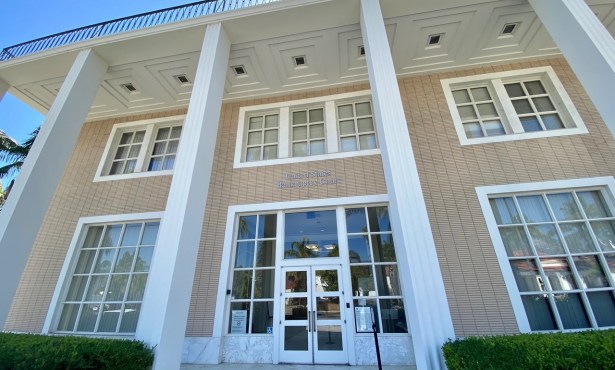Santa Barbara Supervisors Vote to Reduce Jail Capacity
Sheriff Bill Brown and Police Chiefs Argued Against the Plan

Unlike previous county administrators famous for screaming and spitting to make their points, Mona Miyasato doesn’t raise her voice or give in to performative histrionics. So this Tuesday, Miyasato, the county’s chief executive officer, quietly, deliberately, and most emphatically brought the hammer down over how much money the county government should spend locking people up in the county jail. “There has to be some shift,” Miyasato declared toward the end of an intense debate over the fate of the Main Jail — universally acknowledged to be all but beyond repair. “This is not sustainable.”
To make her point, Miyasato brought out some startling statistics. Back in 2005, the jail held 981 inmates, supervised by 245 custody officers, costing the taxpayers $28 million. Today, since an additional jail was built in North County, the overall number of inmates has dropped to 770, but the number of custody employees has increased to 346 — a cost of $90 million.
Sheriff Bill Brown, now in his fifth term in office, was having none of what Miyasato was saying. He forcefully termed her preferred solution “irresponsible” and rejected her preferred option as “not an option at all.” Backing Brown up were the police chiefs of Lompoc, Guadalupe, and Santa Maria. Also joining him was Kelly Duncan, the second-in-command with the District Attorney’s Office and the head of the Deputy Sheriffs’ Association.
Miyasato went into the fray with reinforcements of her own. Late last year, Miyasato had recruited to her executive team Tanja Heitman, the county’s long-serving probation chief who enjoys a detailed knowledge of the county’s sprawling criminal justice system. Tuesday was Heitman’s political debut, and it fell to her to explain to the supervisors how they could limit the number of prisoners at the combined county jail facilities to no more than 728. Currently, there are 771.
During the pandemic, Heitman reminded the supervisors, the jail’s average daily population had dropped from around 900 to 550 with no rise in criminal activity. A consultant hired by Miyasato, Michael Wilson, concluded that the average daily population of the jail could be kept at 600 without placing the public at risk of criminal predation. This assumed that all the movable parts of the criminal justice machinery worked together to keep acutely mentally ill people out of jail in the first place, and that low-level offenders with no history of physical or sexual violence were diverted to restorative programs.

Heitman presented the supervisors with a plan to minimize the Main Jail repairs — at a cost of $27 million — accommodating no more than 128 inmates. Instead, she said, a new pod could be built at the North County Jail with the capacity for 256 beds. That would cost $76 million. This would bring the total capacity of both jails to 728. Another option, she suggested, was for 1.5 additional pods to provide 859 beds. But the last option for 984 beds that would cost considerably more was the one preferred by Sheriff Brown and the police chiefs.
Brown and the chiefs argued that despite statistics showing that crime is on the wane, the lived experience of North County residents is that it’s on the rise.
Nearly 90 percent of people in county jail, Brown told the supervisors, had been charged with felonies, not misdemeanors. Heitman’s assertion that there would be no appreciable population increase in Santa Barbara County over the next 10 years was not accurate. The county’s housing element calls for thousands of new housing units, which would increase population growth more than the consultant had projected. And as law enforcement agencies began to fill many of their vacant positions, more arrests would be made, more charges filed, and more people jailed. The county jail was full when it first opened 60 years ago, Brown said, warning the supervisors they didn’t want to make the same mistake twice.
But Heitman pointed out that 72 percent of the people in county jail had not been tried yet. Sixty of the inmates now in county jail, she said, were acutely mentally ill. Of those, 45 were so seriously mentally ill they’d been deemed incompetent to stand trial. Public Defender Tracy Macuga told the supervisors that there are 117 people now in jail that everyone agrees should be immediately released for treatment — either for mental health or substance abuse — except there are no treatment beds available. Heitman argued that by more aggressively pursuing all the diversion options available, the jail’s average daily population can be kept within the number of 728 beds without putting public safety at risk.
Supervisor Bob Nelson didn’t want to take that chance, calling it a gamble. Supervisor Steve Lavagnino agreed. Supervisor Das Williams argued that Sheriff Brown has not been able to fill many of his custodial vacancies, requiring him to demand mandatory overtime from his understaffed troops, accruing an additional $12 million.
Ultimately, Supervisor Joan Hartmann moved that the county proceed with plans to build one additional pod; if in the next 12 months, it becomes apparent the county cannot meet the diversion goals needed to make the one-pod scenario work out safely, she argued, plans could be drawn up for 1.5. Hartmann’s motion passed by a 3-2 vote.




You must be logged in to post a comment.